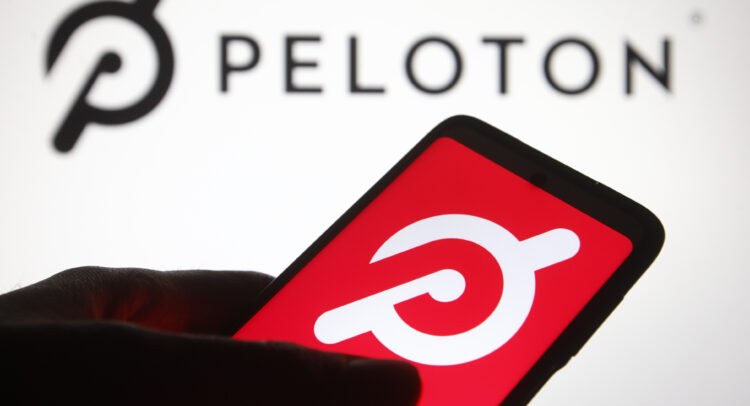Renowned fitness company Peloton (PTON) has dramatically grown from its post-COVID lows. The stock has advanced over 12% on news of the company’s fiscal Q2 results in the past few days. While Peloton presented mixed results overall, it exceeded expectations on adjusted EBITDA. The results suggest that the focus of Peter Stern, the new CEO, on profitability over sales growth, is showing early signs of success. Despite a decrease in hardware sales, subscription revenue has remained a high-margin income stream for the company, generating over $420 million.
The fitness company has also reduced marketing, administration, and R&D costs, leading to better-than-expected results. Peloton’s strategy of moving away from aggressive growth towards cost-effectiveness, with hopes of stabilizing revenue by year-end, has Wall Street analysts revising price targets on the shares upward, suggesting investors holding out looking for signs of life from the company might want to revisit the opportunity.

New CEO, New Strategy
Peloton is one of the world’s largest interactive fitness platforms, with a dedicated community surpassing 6 million members. The platform’s approach incorporates technology to facilitate fitness, streaming immersive, instructor-led boutique classes to members at their convenience from any location. The offerings are diverse, with instructors providing classes in various fitness and wellness categories such as indoor cycling, indoor/outdoor running and walking, bootcamp, yoga, strength training, stretching, and meditation.
Peloton’s new CEO, Peter Stern, has emphasized the company’s commitment to improving gross margins, reducing operating costs, and deleveraging the balance sheet. Stern, a former Ford (F) executive, and Apple Fitness+ (AAPL) co-founder aims to improve Peloton’s financial health before refocusing on sales growth.
These efforts have paid early dividends, resulting in an increase in the gross margin on its expensive stationary bikes and treadmills to 12.9%, marking the first time it has reached double digits in over three years. Further, the company has made cuts in three areas where it has been criticized for overspending—marketing, administrative costs, and research and development—leading to a significant increase in adjusted EBITDA.
Financial Metrics are Improving
The company announced results for the most recent financial quarter, reporting total revenue of $673.9 million, exceeding analysts’ expectations by $20.62 million. Sales of premium-priced hardware products were higher than anticipated, contributing to the outperformance, while the number of mid-range product sales was lower than expected. Meanwhile, lowering advertising and marketing spend, along with improved higher-paid connected fitness subscriptions, resulted in higher-than-expected subscription revenue.
Gross profit for the quarter was $318.4 million, a 6% increase year-over-year. Operating expenses were $364.3 million, reflecting a 25% reduction year-over-year. Adjusted EBITDA for the quarter was $58.4 million, exceeding guidance by $28.4 million. However, GAAP earnings per share (EPS) of -$0.24 missed consensus expectations by $0.05.
The financial quarter ended with $829.0 million in unrestricted cash and cash equivalents, a quarter-over-quarter increase of $106.6 million.
Management has increased its full-year Fiscal 2025 forecast, slightly raising its fiscal 2025 revenue guidance to $2.43-$2.48 billion, spurred by an increase in Paid Connected Fitness Subscriptions and a favorable performance of the Tread portfolio. The company anticipates adjusted EBITDA to be $300-$350 million, a $60 million boost driven by gross margin growth and continued fiscal prudence. The free cash flow target has also been raised by $75 million to at least $200 million, a reflection of operational efficiencies and improvements in inventory management.
Stock Reflects Peloton’s Gradual Turnaround
While the stock has not fully recovered from the bursting of its COVID-induced bubble and may never see the kind of valuation it enjoyed in early 2021, it has shown signs of life in the second half of 2024, climbing roughly 180% in the past six months. It trades near the upper quartile of its 52-week price range of $2.70 – $10.90 and shows ongoing positive momentum as it trades above most major moving averages. The P/S ratio of 1.2x is roughly in line with peers in the Consumer Discretionary sector, where the average P/S ratio sits at 0.97x.
Analysts following the company have remained cautious about PTON stock, though the recent results have caused some to upwardly revise their 12-month price targets. For instance, Truist analyst Youssef Squali, a four-star analyst, recently raised the price target on the shares to $11 (from $10) while maintaining a Hold rating, noting that Q2 results and management’s outlook show a gradual improvement in the company’s ongoing turnaround.
Peloton Interactive is rated a Hold overall, based on the recent recommendations of 14 analysts. The average price target for PTON stock is $9.98, which represents a potential upside of 19.24% from current levels.

PTON Stock in Summary
Peloton’s recent strides in profitability, thanks to a new cost-effective approach under CEO Peter Stern, has created a resurgence of interest from Wall Street, as reflected in the recent 12% stock increase. Despite hardware sales decreases, the company has maintained a steady income stream through its subscription revenue and has significantly reduced costs in marketing, administration, and R&D. Furthermore, Peloton’s outlook for the near future is positive, with revised revenue guidance for fiscal 2025 hinting at consistent progress. While the company has yet to fully recover from its post-pandemic slump, the recent signs of life in the stock and revised upward price targets suggest this might be a good time for investors to take another look at PTON.
















